See all 3 ways of how to clean pizza steels, whether you used it for baking pizza, baking bread, or as a stovetop griddle. See light or heavy cleaning, maintenance, and storage of your pizza steel. This is part of our Food Equipment & Tools, Pizzas, Bakery, and Bread categories.
What is a Pizza Steel or Baking Steel?
A pizza steel, also know as “baking steel”, is a thick piece of steel with a durable and versatile cooking surface. It’s very popular when used for baking pizzas or breads. Also, it’s an alternative in place of a baking stone or pizza stone.
Also, there is a “griddle baking steel” that is just a pizza steel that has an added feature of a drip channel around the entire edge. The griddle baking steel is mostly for the stovetop.
Typically, pizza steels come in various thicknesses like 1/4-inch, 1/3-inch, and the very heavy 1/2-inch.
Overview of How To Clean Pizza Steel
There are several different ways and times of how to clean pizza steels. The cleaning method is dependent on how it has been used. It also depends if it needs a deeper scrubbing instead of the routine cleaning.
Maintenance and Importance of How to Clean Pizza Steels
Learning how to clean pizza steels will ensure it has a long life and is always immediately ready for cooking.
1st Way: How To Clean Pizza Steel AFTER EACH USE
How To Clean Pizza Steel or Griddle After Each Use
After it’s cooled down, can clean the pizza steel (or griddle) in a sink similar to cleaning a typical pot. Use a plastic scraper or spatula to clear off any food residue. Then, wash it with dish detergent (e.g., Dawn) and water, using a non-metal scrubbing sponge. For tough baked on foods, use baking soda or Bar Keepers Friend cleanser to scrub off. Wipe it thoroughly dry.
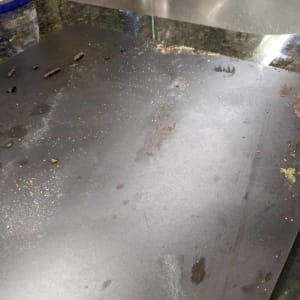
- After baking a pizza, let pizza steel cool down.
2. Run water over it and scrape off excess food residue.

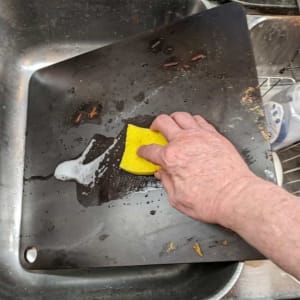
3. Scrub with Dawn dish detergent or baking soda, and water.
4. Finish by rinsing fully with water and then wiping fully dry with paper towels.

How To Clean Pizza Steel After Baking Bread
Ensure it’s cooled down. Then, wipe it down with a wet paper towel and thoroughly dry it. If any bread crust or residue, use a plastic scraper or spatula to clear it off. Then, wipe it thoroughly dry.
2nd Way: How To DEEP CLEAN Pizza Steel After Many Uses
After many uses, you’ll work on deep cleaning a pizza steel. This kind of deep scrubbing involves about 15 minutes to perform. I do it once or twice a year usually. Usually it takes a special cleanser, special scrubber, or both. Keep reading for a workaround for using regular household items on this.
Cleaning Pizza Steel starts by letting it cool down and placing it in sink.
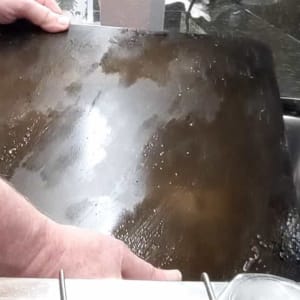
Types of CLEANSERS for Deep Cleaning a Pizza Steel
Here are 3 types of cleansers you can use for cleaning a pizza steel.
- Dish detergent like Dawn
- Baking soda
- Bar Keepers Friend cleanser
You do not want to use the harsh chemical types of cleansers like Ajax or Comet.
Types of SCRUBBERS for Cleaning a Pizza Steel Thoroughly
For regular or deep cleaning a pizza steel, you can use the common 2 sided sponge scrubber for dishes. That’s the kind that has a sponge on one side and the other is a coarse, nylon scrubber for scouring the tough stuff. Or, you can use a strong bristle nylon brush. Don’t use anything made of metal, like `certain SOS pads.
About Cleaning Bricks for Pizza Steels
For professional results, use a “pumice stone brick”. A popular brand is the “EarthStone cleaning block”. This type of “pizza steel cleaning brick” (aka baking steel cleaning brick) is a rectangular porous block shaped item. It looks like a building brick but is usually much smaller in size. Here are some listed details on using a pumice stone brick.
- It’s extremely light and easily handled with one hand.
- Dimensions are about 4 x 1.5 x 3 inches.
- The material of pumice stone is all natural and non-toxic.
- The advantage of using a pumice brick is you don’t use any detergent or cleanser.
- They’re also sometimes used for cleaning outdoor grilling surfaces.
- Also, it results in a very smooth finish without damaging your steel’s surface.
- TIP: Avoid cleaning bricks that aren’t made of pumice stone or other natural materials.
Step-by-Step Deep Clean A Pizza Steel
This is for how to deep clean a pizza steel thoroughly and completely. It uses a cleaning block such as a pumice stone cleaning brick.
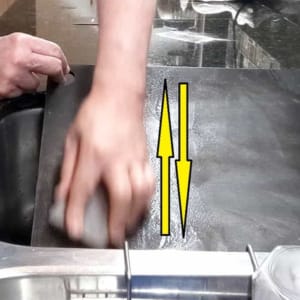
Long vertical, horizontal, and circular scrubbing strokes across entire pizza steel surface using a cleaning block
- Ensure the pizza steel is completely cooled down, out of the oven. If just used for cooking, it takes usually a minimum of 2 hours, depending on its thickness.
- Scrape off all stuck on residue. Use a plastic or nylon scraper or bench scraper for that. Here’s a good article on “What is a Bench Scraper?“. You can do this using running water which can help.
- Next, use Dawn dish detergent, baking soda, or Bar Keepers Friend cleanser to clean it like you usually do after a baking session. Rinse it off. No need to dry it.
- For the next 5-10 minutes, use your pumice stone brick and begin scrubbing back and forth,, across the entire surface.
- Sometimes change to circular motions.
- About every 1/2 minute, rinse off the pumice brick itself and sometimes rinse off the pizza steel.
- Also, be sure to flip it over and scrub the other side and edges.
- After cleaning is done, rinse the brick and the steel off thoroughly on both sides and edges.
- Then, shake the brick of excess water and set it aside to dry off overnight.
- Dry off the pizza steel completely, consider seasoning it, and store it away.
After deep cleaning, dry off completely, opt to season it, and store it away.
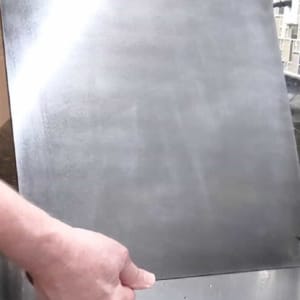
3rd Way: How To Clean Pizza Steel Before Its First Use
How to clean pizza steels when you first get it new is critical. So, follow the instructions that came with it from your manufacturer. Here’s a list of steps to consider before initial usage, if you have no guide.
- Inspect the quality of the steel after fully removing it from its packaging. Check for any metal flaws or burs that can be a safety concern. If okay, go to the next step.
- Mildly wash it with dish detergent, and thoroughly dry it.
- If it’s pre-seasoned already, skip this step. Otherwise, lightly coat it with flaxseed oil or olive oil. Bake it in a preheated 500 degree F oven for one hour. Remove it, let it cool down fully to room temperature.
- Store it on its edge or completely flat on a shelf. Using either method, ensure the entire steel’s edge or surface is fully supported on the shelf with nothing hanging over past the shelf.
I’ve looked for several pizza steel cleaning videos. This is the best I’ve seen. So, here is a Pizza Steel manufacturer’s recommendations for “How To Clean Baking Steel Out of the Box“. And, they’ve included a good video showing how to clean a baking steel also. It shows a griddle because it’s 100% identical to cleaning a pizza steel, baking steel, and griddle. The only difference is this has a groove around the edge.
Advanced Steel Cleaning Methods: Expert Tips
Preparing Pizza Steel For Cleaning
Remove the pizza steel from the oven to cool down faster, which might take about 1-2 hours or longer. Use a bench scraper or other nonmetal scrubber to remove the baked on food residue. Sometimes, a pumice stone brick or EarthStone cleaner block will also work. Then, perform your cleaning as usual.
How To Remove Stuck Or Burnt-On Foods
As mentioned earlier, you can use any nylon scrubber, a bench scraper, or a pumice stone brick or EarthStone block. However, there have been a couple of times I had to do something else. So, I ran water over it, sprayed it with Dawn dish detergent, waited 15 minutes, and scrubbed again. One time, I had to repeat that process, and then it all came off.
How To Tackle Stubborn Stains or Spots
Regarding removing stubborn stains or tough spots on the pizza steel, I only focus on those when deep cleaning. These always come out for me when using Bar Keepers Friend cleanser, followed by rinsing and scrubbing with the pumice stone block.
More About Pumice Stone Cleaning Bricks
Using this type of scrubber wears it down so, a deep cleaning session often consumes an entire brick. I order as a pack of 4 pumice stone bricks. As an alternative, you can also look for the EarthStone Cleaning Blocks or other brands that I’ve seen on Amazon.
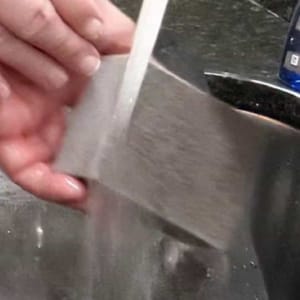
Rinsing off pumice stone cleaning brick while deep cleaning pizza steel
Things To Never Do When Cleaning A Pizza Steel
- Never insert a pizza steel into a dish washer. It’s not for cleaning, rinsing, nor drying a pizza steel ever.
- Never use a strong, harsh or toxic cleanser such as Ajax or Comet for scrubbing or cleaning a pizza steel.
- Don’t try to speed up the cooling down process such as putting in the fridge, in the freezer, or running cold water over a hot pizza steel.
- Don’t use any car cleaning products or polishes to try and make it “shine”.
- Avoid using any scouring pads made with metal.
- Finally, don’t ever use sand paper on the cooking surface area.
What To Do After Cleaning a Pizza Steel
How To Dry A Cleaned Pizza Steel
I dry mine with paper towels very, very thoroughly. Then, apply a very thin coating of olive oil and wiping off any excess, again using paper towels. Others will say to heat it in the oven, which I have never found necessary. However, mine uses American made steel, and has never shown any sign of rust or warping, after many years.
How To Season a Pizza Steel After Cleaning
Here is the step-by-step procedure for properly seasoning your pizza steel.
- Preheat your oven to 500 degrees Fahrenheit (or at least 450 F).
- While preheating (or before), perform a deep, thorough cleaning of both sides and edges.
- After drying it off, apply a thin coating of flaxseed oil or olive oil on both sides and its edges.
- Then, wipe all the excess oil off with paper towels. It should not be too oily to handle. It should only have a slightly shiny sheen on its surface.
- Place the pizza steel in the preheated oven for about 45 to 60 minutes.
- After the baking time is done, turn off the oven. Leave the pizza steel in the oven as it all cools down.
- After about 2 hours, remove the steel and let it cool down the rest of the way outside the oven. Or, you can just leave it in the shutoff oven overnight and remove it in the morning.
- After its back to room temperature, store the clean, seasoned pizza steel as described in the next section.
How To Store a Pizza Steel
Storing a Pizza Steel for Routine Use
For routine storage, you have 2 proper options.
- Firstly, place it laying down flat on a shelf. However, the shelf must be big enough to support the entire pizza steel and no part of it should be sticking out past the shelf.
- Secondly, you can place the steel on its edge, again with no part of it being off a shelf. Use caution that it won’t mistakenly tip over or fall when storing it on its edge.
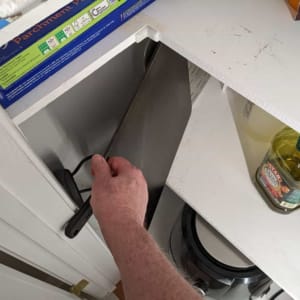
Store pizza steel on its edge or laying flat on a deep pantry shelf.
Storing a Pizza Steel for Long Term Nonuse
For long term storage, its best to perform a deep, though cleaning first. Then, season it as shown in this article. After that, completely wrap it in a cloth to fully cover it and its edges. It can then be stored in any container that will protect it from any long term moisture or humidity. Or, it can be wrapped up and sealed in a good plastic wrapping and placed on a shelf.
Conclusion of How To Clean Pizza Steels
You’ve now seen how to clean pizza steel, maintain it, and store it properly. You’ve seen the 3 cleaning scenarios: when its new, after each use, or when deep cleaning. Also, you’ve learned the different cleansers and scrubbers to use, like a cleaning block. Finally, you learned proper storage methods and a seasoning process, all for a long life of usage. Now, get your cleansers and cleaning blocks ordered to be ready for cleaning after baking your next pizza or bread!

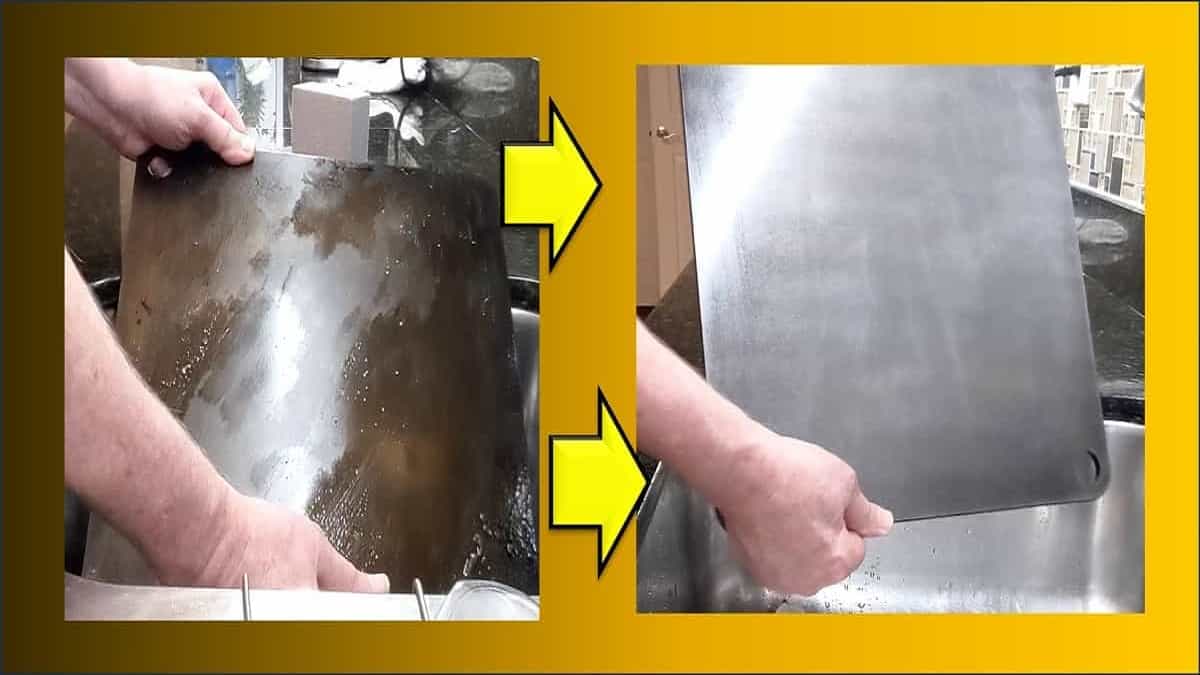
3 comments
Travis Quisquam
I’ve read several of your posts. This one helped me clean my pizza steel a ton better. I wasn’t sure how to get the thick burnt areas off safely. Thanks for showing that.
Georgiana Min
Thanks for this detailed cleaning of pizza steels article. I thought this post was great. Cheers.
Christian Quisquam
I just could not leave your web site. I really enjoyed the variety of recipes and articles you’ve made. I’m returning every now and then to check up on new posts.